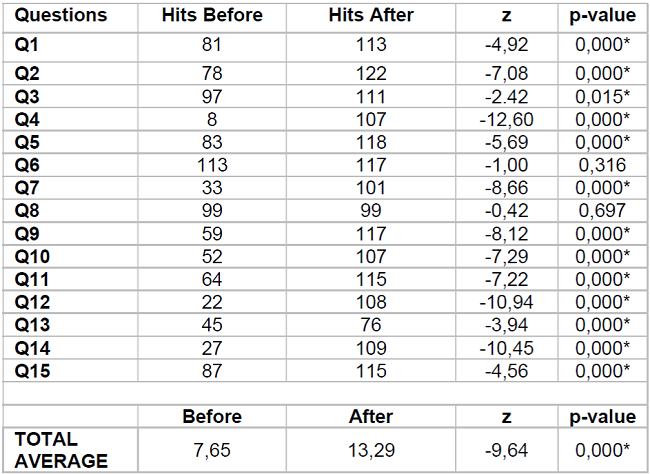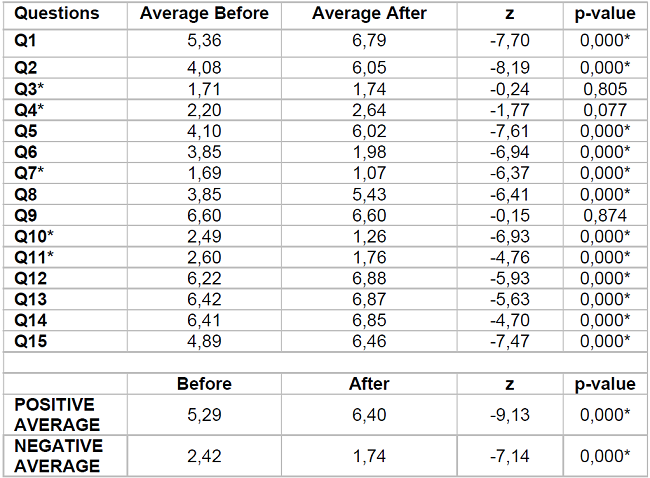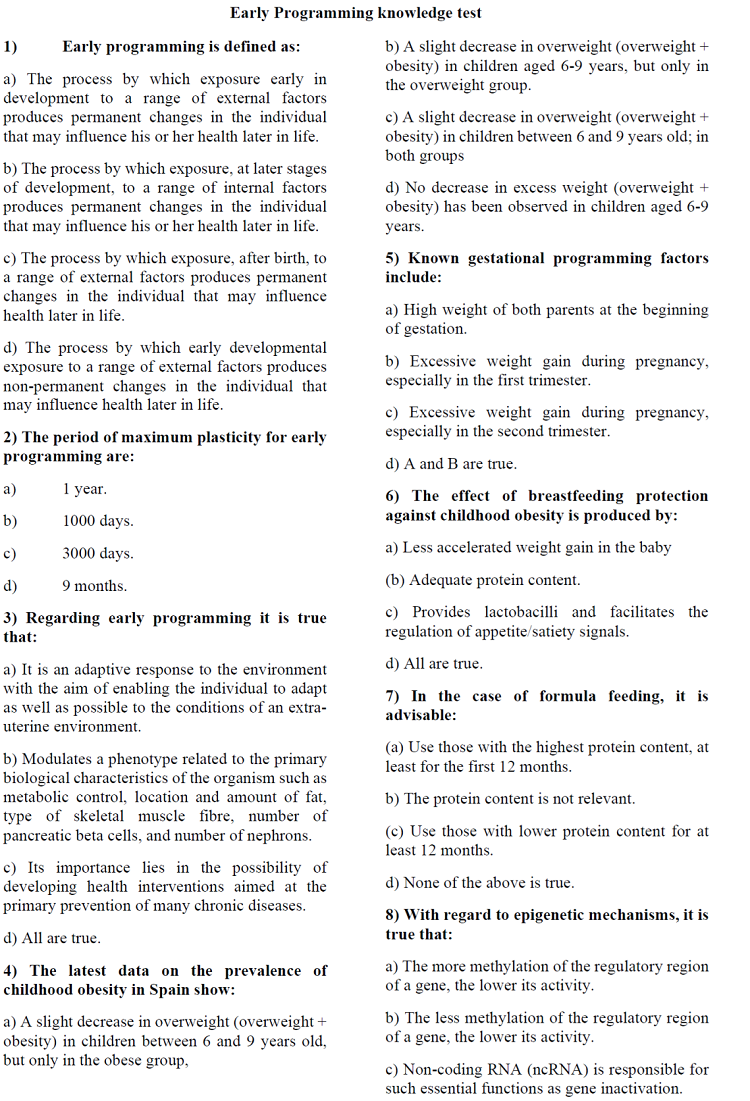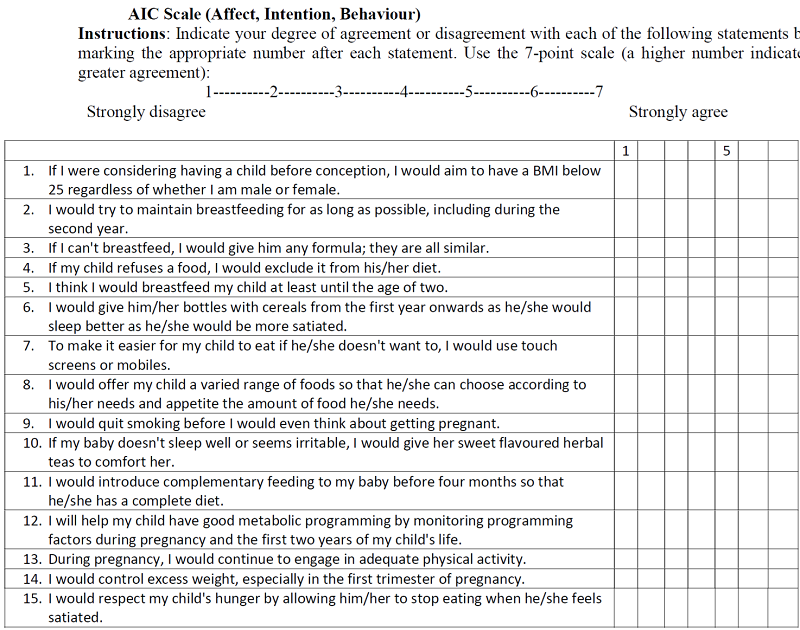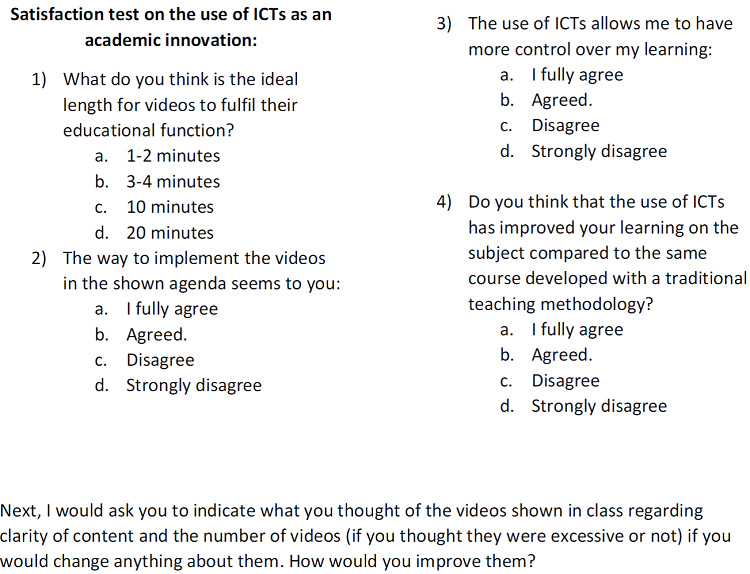Meu SciELO
Serviços Personalizados
Journal
Artigo
Indicadores
-
 Citado por SciELO
Citado por SciELO -
 Acessos
Acessos
Links relacionados
-
 Citado por Google
Citado por Google -
 Similares em
SciELO
Similares em
SciELO -
 Similares em Google
Similares em Google
Compartilhar
Enfermería Global
versão On-line ISSN 1695-6141
Enferm. glob. vol.21 no.67 Murcia Jul. 2022 Epub 19-Set-2022
https://dx.doi.org/10.6018/eglobal.499001
Originals
Educational pills to improve nursing education on early programming
1Department of Nursing and Physiotherapy, University of Cadiz. Cádiz. Spain
2Department of Didactics and Educational Organisation, University School of Osuna. Sevilla. Spain
Background:
Childhood obesity has been declared the epidemic of the 21st century. Early programming is an essential element that should be used to prevent non-communicable diseases. Nurses are uniquely positioned to apply this concept, but it is not included in their education.
Objectives:
The development, implementation and evaluation of the use of educational pills offered to nurse students to improve their knowledge of early programming.
Methodology:
This is quasi-experimental research. It is a pre/post study with a longitudinal follow-up. For data collection, three self-developed questionnaires were designed to measure the level of knowledge, intention to act and satisfaction with the methodology. The level of knowledge and the intention to act were measured before and after the intervention to see the intervention's effect. Satisfaction with the methodology and resources used was measured after the intervention. The population included in this study is the first-year and second-year nursing students enrolled in two different subjects in the academic year 2019/2020. The population size is estimated to be 200 students. We have organised the process into three defined stages: the initial stage, elaboration stage and implementation stage.
Conclusions:
The intervention has improved the knowledge of future nurses about early programming and has increased the intention of nurses to act. Students find this methodology suiTable for their training.
Key Words: Obesity; midwifes; nursing; education; intervention
INTRODUCTION
Childhood obesity has been declared the epidemic of the 21st century(1. According to the WHO, the rate of obesity among children under five years of age has risen from 31 million in 1990 to 42 million in 2016 worldwide. If this trend continues, this number is expected to rise to 25 million by 2025(2. These data show the urgent need to change this situation, not only because of the importance of this disease and its comorbidity but also because of the cost of the disease(3,4)but also because of the cost it represents and will represent for public health care in the future, given that most obese children end up as obese adults(5,6.
Public administrations, families and health professionals have been trying to reverse this worrying situation7 8 9. However, these efforts have not had the expected effect(10 11 12 13. In this scenario, a research trend is emerging which suggests that strategies should be aimed at prevention and begin at much earlier ages, including the gestational stage of pregnancy(14including the mother's gestational stage, since it is in this period that the genesis of the physical and psychological health of the being that is being formed is found. It is the most fundamental prevention of dysfunctions, among which obesity stands out.
Early programming was already conceived in the 20th century and is presented as a tool to change the approach to interventions(15,16and is presented as a tool to change the focus of interventions.Programmingis the term used to refer to an effect with long-term and most likely lifelong consequences, such as nutritional or metabolic programming. However, it is only in recent years that this concept has begun to be used. Few interventions cover the entire gestational period and the first thousand days as a preventive strategy(17.
As might be expected, this concept and the underlying knowledge are far from being integrated into the academic curricula of any health training and, in particular, in the nursing degree, when these professionals are in a critical position to integrate this tool into clinical practice. Midwives are the ones who accompany mothers throughout pregnancy from the very beginning. The work carried out by nurses is crucial and can positively impact the development of the baby-child-adult. Some studies confirm that the level of education and accompaniment received by mothers during pregnancy by nursing staff improves their quality of life and reduces pregnancy complications18. At the same time, numerous epidemiological and experimental studies link early programming with the prevention of illnesses, especially obesity prevention. However, there is a lack of nursing training on crucial issues such as nutrition during pregnancy and breastfeeding(19 20 21.
Therefore, due to the strategic position of nursing professionals and given the positive impact this can have on people's health, efforts are urgently needed to ensure that early programming and the knowledge, procedures and interventions underlying this concept are integrated into initial and continuing nursing education.
Although it is true that reading texts and study guides continue to be the primary teaching material in most university degrees, other resources of a more technological nature are increasingly being integrated into the classroom, using ICTs as a learning methodology. The use of audiovisual resources for educational purposes has increased exponentially recently, with video being one of the most prominent among them(22. According to Conopoima y Ferreira23, the video makes the teaching-learning process more attractive in modern times due to its flexibility and scope(24.
SPs are training resources with great potential to favour the learning of specific content units, as in the case of this work, as they respond to characteristics such as brevity, atomisation and concentration of the content on a specific topic and the use of images and animations, which allow them to capture the students' attention by presenting information interactively and dynamically(25. This allows the students' attention to be captured by presenting the information interactively and dynamically. It is closely related to the concept of micro-content, as it allows for content and information structured in short, concentrated, detailed, well-defined and interconnected chapters26.
In this way, three needs are identified to which a response is sought: 1) the urgency of curbing the trend of childhood obesity; 2) the necessary training of nursing professionals in the field of early programming, given their crucial position in tackling it; 3) the introduction of new didactic and methodological resources in university classrooms such as with educational pills.
MATERIALS AND METHODS
Target
The main objective of this study is the development, implementation and evaluation of the use of educational pills as an attractive, flexible and effective audiovisual resource offered to students of the nursing degree at the university where the research is being carried out, with the aim of improving their knowledge of early programming for its application in their future professional practice.
Type of study
This is quasi-experimental research. It is a pre/post study in which the same population group is analysed at two different points, before and after the intervention. Therefore, it is a longitudinal follow-up of the study group with a quantitative analysis of the data collected.
Population
The population included in this study is the first-year nursing students enrolled in the subject "Food, nutrition and dietetics" and the second-year nursing students enrolled in "Community nursing" in the academic year 2019/2020 at the university in question.
The population size is estimated to be 200 students as these are the students enrolled in these subjects in the indicated academic year. However, part of this population is lost due to non-attendance in class on the days of the intervention, so the final sample size is 124.
Instruments for collecting information
As the content is new and not widely disseminated, there are no previously validated tools, so three questionnaires were used, drawn up by a committee of experts made up of a paediatrician, an expert in the prevention of childhood obesity, and three lecturers from the degree in nursing, experts in nutrition, prevention of childhood obesity, empathetic communication and training of the degree students. These questionnaires were used to measure the level of knowledge, intention to act and satisfaction with the learning methodology.
The structure of the instruments is as follows:
The knowledge level questionnaire consists of 15 questions with four answer options, one of which is correct.
The intention to act questionnaire consists of 15 statements on early programming to be rated on a Likert scale from 1 to 7. There are nine correct statements regarding early programming and six incorrect ones among these questions.
The questionnaire on satisfaction with learning consists of 4 questions with four answer options, and the nature of the answer is informative, with no right or wrong answer.
These questionnaires are available as annexes at the end of the text:Annex I, knowledge questionnaire;Annex II, intention questionnaire;Annex III, satisfaction questionnaire.
Initial stage
For the structure and organisation of the contents, the research group's expertise dedicated to early programming was used. Eight scripts were produced, corresponding to the number of educational pills produced. The contents were divided so that each capsule presents a concept and develops it. In this way, the capsules address the following contents:
Concept of early programming - what is it?
How does early programming work?
Relationship of early programming to future adult diseases.
Relationship of early programming to obesity.
How to achieve good early programming during pregnancy?
How to manage programming factors in the first year of life?
Continuation and acquisition of good lifestyle habits.
Thanks to good programming, it is now their turn.
Processing stage
After the scripts were modified until they were finalised, the audio was recorded to produce the learning capsules. These audios were recorded in the facilities offered by the university in a research centre with the help of an audiovisual technician.
Finally, the audiovisual content was prepared using the previously prepared recordings. For this process, an audiovisual technician from the university helped us capture the researchers' ideas, depending on the content of the audio. It was decided that the length of the videos should not exceed 3 minutes. The aim was to obtain content and a way of presenting it that would be attractive and close to the students, considering their average age. In addition, we tried to ensure that the concepts were well explained in a clear, concise and dynamic way for the students. For the same purpose, the videos were limited to a few minutes (2-3 minutes).
Implementation stage
The intervention took place in duplicate in the two participating subjects. On both occasions, it took place in the same way, so from now on, we will refer to the development of one time as the development of both.
The intervention lasted two hours. First, an explanation of the activity was given to the students in attendance. The initial knowledge and intention questionnaires were distributed to the students, and an identification number was randomly assigned to each student so that the questionnaires were linked pre/post anonymously. These questionnaires were collected before the start of the learning capsule presentation.
After the explanation and application of the initial questionnaire, the first four capsules were viewed, focusing on the more theoretical content on the concept of early programming, how it works and what it affects. After this viewing, there was a question-and-answer session and a debate in which the students participated actively, raising and clarifying doubts among themselves with the help and support of the researchers.
Once this first section was completed, the following four capsules were presented, focusing on implementing the concepts explained previously. In the same way, a question and discussion session were established in which the students finished clarifying their doubts and processed the concepts presented.
It was decided to administer the post questionnaire in the following class session, allowing the students to view the videos again and take advantage of the benefits of this type of educational resource. Thus, one week after the session, the knowledge and intention questionnaires were administered again in the following session, now labelled as post, ensuring that the identifier number was the same in the pretest and the postest for data analysis purposes. In addition, the questionnaire of satisfaction with the methodology used was administered.
Statistical analysis
Firstly, a descriptive analysis of the data obtained was carried out using the most frequent statistics (mean and deviation in the case of continuous variables, frequencies and percentages in the case of discrete variables).
The normality of the variables associated with the questionnaires was checked with the Kolmogorov-Smirnov test. In the case of normality, the student's t-test was used to compare means (also in the case of paired means). In case of non-normality, the Mann-Whitney U-test for independent means and the Wilcoxon W-test for paired means shall be used. The McNemar test, equivalent to the chi-square test for non-independent samples, shall be used to compare paired proportions.
All the information obtained was transcribed into a computerised database using the statistical programme SPSS (version 24) for Windows, allowing its subsequent statistical analysis, taking the standard 0.05 level of significance as the significance level.
RESULTS
The results of the first questionnaire are shown inTable 1. It can be seen that there is a significant difference in the correct answers to all questions except Q6 and Q8.
Regarding the average number of responses per student, the associated variables were non-normal according to the K-S test. The W-test showed significant differences, with the number of correct answers being higher in the knowledge questionnaire after the intervention. AsTable 2shows, there were differences in the responses of the two groups before the intervention, but after the intervention, these differences did not occur.
Table 3shows the average responses for each question before and after the intention to act questionnaire. Given the non-normality of the responses, non-parametric tests were used.
The questionnaire shows significant changes in all questions except Q3, Q4 and Q9, as well as an increase on average in the number of questions to be answered positively and a decrease in the number of questions to be answered negatively.
As shown inTable 4, between the two subjects, there is only a significant difference in negative responses before the intervention, all other group data being equal.
Finally, the third questionnaire dealt with the opinion on the methodology used in the intervention.Table 5shows the descriptive data of this questionnaire and the data by subject.
Although satisfaction is significantly higher in the community group, there is a reasonable degree of satisfaction with the methodology (Q2, Q3 and Q4). Q1, which deals with the duration of the capsules, shows that the majority of the respondents prefer a duration of 1 to 4 minutes, with option b (3-4 minutes) being the most popular option.
DISCUSSION
The analysis presented here shows the success of supporting teaching practice with learning resources such as educational pills. These results are in line with the results provided by Giurgiu26, Luesma27, and Sirwan-Mohammed(28, among others, which highlight that the use of educational pills makes the learning process more attractive, flexible and efficient as it allows them to learn more quickly and adapts favourably to their personal needs.
The analysis shows significant differences between the number of questions answered correctly before and after the intervention in both groups. Moreover, this significant difference is observed in each of the questions analysed independently, except for questions 6 and 8. In other words, there is a positive tendency to get the questions right after the intervention. Questions 6 and 8, in which no significant differences are found, correspond to knowledge about breastfeeding (Q. 6) and epigenetics (Q.8).
Regarding item 6, "The effect of breastfeeding protection against childhood obesity is produced by...", the non-observation of significant differences could be because the benefits of breastfeeding is a topic that is currently being widely disseminated in society, and that students may already be aware of. In order to justify this, we rely on the results provided by García Ceballos29. In this study, which assesses nursing students' knowledge about breastfeeding, we observed an average level of knowledge, which is why they could have answered questions of this type correctly.
For question number 8: "With regard to epigenetic mechanisms, it is true that...", we can find as an explanation that these are science students who have some knowledge of genetics as they have studied this type of subject before.
However, the significant differences found in the rest of the questions specific to early programming, such as questions 1-3, 5, 9, 10 and 13, show that, although future nurses may have some knowledge about breastfeeding in general or about genetics, they do not have the capacity, without specific training, to relate and apply this knowledge to the future health of newborns.
On the other hand, a significant difference was found between the number of correct answers before the intervention between the two groups corresponding to both subjects. The students of the subject "Community Nursing" have a higher number of correct answers before the intervention than the students of the subject "Nutrition". This could be explained by the fact that the students in the first group belong to the second year of the nursing degree and therefore have more prior knowledge than those in the second group, who belong to the first year and have not yet reached the same level of training.
We also found significant differences between pre- and post-intervention responses in the intention to act questionnaire. These differences were not found in questions 3, 4 and 9. Again, in this questionnaire, we observed no significant differences in those questions that refer to concepts that are more widespread in the general population. In this case, these concepts are breastfeeding (Q.3: "If I cannot breastfeed, I would give any formula milk; they are all similar"), the general diet of the baby (Q.4: "If my child rejected a food I would exclude it from his/her diet") and smoking during pregnancy (Q.9: "I would stop smoking before thinking about becoming pregnant").
This is since the students are previously aware of these concepts as they are integrated into society. However, given the answers obtained in the rest of the specific questions of the early programming, they do not have a vision of the need to act on these factors to prevent the development of future diseases, such as obesity. On the other hand, once the intervention has been developed, this opinion changes, thus improving their view of the problem and their role as future health professionals in the health of their patients.
Concerning the students' degree of satisfaction with the intervention, we found that the students in both groups were delighted with the innovation. In particular, a higher degree of satisfaction is found among the students in the community group. This is a good result, as the students in this group are in a higher grade than the other students, so they have a more well-formed opinion about the education received at the university and the usefulness of the concepts and methodologies offered. These results are similar to those found in Luesma's (27study, whose analysis of the satisfaction survey reveals the benefits of the educational pills in the learning process.
Finally, taking into account the comments added by the students at the end of the questionnaire, we would like to highlight, as aspects to be improved, that it would be advisable to make a more significant number of stops to clarify doubts and raise debate between the viewing of the videos. The pills were first shown four in a row, with a stop for clarification of concepts and discussion, and finally, the other four. According to the students' opinions, putting the videos in blocks of two with intermediate stops, or even one at a time, would be more effective.
CONCLUSIONS
Given the results, we can conclude that the intervention has achieved significant results in all the aspects measured. The students have learnt and integrated the concepts, as seen from the scores achieved in the knowledge questionnaire. Furthermore, these future health professionals have significantly improved their intention to act on these concepts personally and professionally with their future patients.
The evaluations obtained by the students due to the application of the methodology used have been favourable. The students consider that this format has made it possible to incorporate the concepts presented in a better way than if it had been carried out using traditional methodology. The students found the duration of the activity and the pills to be appropriate. However, they would include a more significant number of pauses between the viewing of each of them to clarify doubts and establish a debate.
Therefore, it is evident that this type of intervention effectively transmits knowledge to students, obtaining better results than the traditional master class, which encourages follow-up work towards this type of learning resource.
The experience obtained in the implementation of this resource in the university's nursing degree allows us to point out the need to change or complement traditional teaching with other types of methodologies and resources, such as educational pills, as it has allowed the necessary content to be addressed dynamically and attractively for students. Moreover, their format allows the content to be focused on the most critical points, which improves learning.
In the words of Conopoima and Ferreira23, "Even though it is a complementary strategy, its potential to facilitate the incorporation of new knowledge and improve the understanding of certain subjects that could be labelled as complex, boring or broad within the curriculum is unquestionable".
Finally, in terms of future projects, it would be interesting to go further in new methodologies and implement one such as the flipped classroom, whose effectiveness is evidenced in this 2018 study in which the advantages of reversing the role of students in the teaching of future health professionals are observed.(30whose effectiveness is evidenced in this 2018 study in which the advantages of inverting the role of students in the teaching of future health professionals are observed. Innovation can be proposed in which the knowledge of early programming is presented through role reversal, in such a way that it is the students who carry out a search for evidence on the subject and must critically analyse the information found for a subsequent sharing and debate guided by the teacher from which they will extract knowledge on the subject. In this way, education from "evidence-based practice" is also used, which also needs to be introduced in the teaching of future nurses so that they are familiar with the tools and methods of evidence-based practice.(31so that they are familiar with the tools and procedures as professionals.
REFERENCES
1. Salud 57o asamblea mundial de la. Estrategia Mundial sobre Régimen Alimentario, Actividad Física y Salud. Genéve: OMS; 2004. 2006. p. 22-7. [ Links ]
2. OMS. Datos y cifras sobre obesidad infantil [Internet]. WHO. World Health Organization; 2017 [cited 2020 Dec 1]. Available from: http://www.who.int/end-childhood-obesity/facts/es/ [ Links ]
3. Garg SK, Maurer H, Reed K, Selagamsetty R. Diabetes and cancer: two diseases with obesity as a common risk factor. Diabetes, Obes Metab [Internet]. 2014 Feb [cited 2019 Feb 14];16(2):97-110. Available from: http://www.ncbi.nlm.nih.gov/pubmed/23668396 [ Links ]
4. Kachur S, Lavie CJ, de Schutter A, Milani R V, Ventura HO. Obesity and cardiovascular diseases. Minerva Med [Internet]. 2017 Jun [cited 2019 Feb 14];108(3):212-28. Available from: http://www.ncbi.nlm.nih.gov/pubmed/28150485 [ Links ]
5. AESAN. Prevalencia de sobrepeso y obesidad en España en el informe "The heavy burden of obesity" y en otras fuentes de datos [Internet]. 2019 [cited 2020 Sep 7]. Available from: http://www.aecosan.msssi.gob.es/AECOSAN/docs/documentos/nutricion/observatorio/Resumen_resultados_informe_OCD-NAOS.pdf [ Links ]
6. Hernáez Á, Zomeño MD, Dégano IR, Pérez-Fernández S, Goday A, Vila J, et al. Excess Weight in Spain: Current Situation, Projections for 2030, and Estimated Direct Extra Cost for the Spanish Health System. Rev Esp Cardiol [Internet]. 2019 Nov 1 [cited 2020 Sep 4];72(11):916-24. Available from: http://www.revespcardiol.org/es-exceso-peso-espana-situacion-actual-articulo-S0300893218303877 [ Links ]
7. Consejería de Igualdad S y PS. Programa de Salud Infantil y Adolescente de Andalucía. 2014 [cited 2019 Mar 14]; Available from: http://www.juntadeandalucia.es/educacion/portals/delegate/content/e84541cc-306c-4f01-8d68-19aadc05fc57 [ Links ]
8. Consejería de Salud - Junta de Andalucía. Plan Integral de Obesidad Infantil de Andalucía 2007-2012 [Internet]. 2012 [cited 2019 Mar 14]. Available from: https://www.juntadeandalucia.es/export/drupaljda/salud_5af065344e865_ponencia_pi_obesidad_infantil.pdf [ Links ]
9. Consumo M de S y. Estraregia NAOS: Estrategia para la nutrición, actividad física y prevención de la obesidad. [Internet]. 2005 [cited 2019 Jun 19]. Available from: http://www.aecosan.msssi.gob.es/AECOSAN/docs/documentos/nutricion/estrategianaos.pdf [ Links ]
10. AESAN. Estudio ALADINO 2011 [Internet]. 2013 [cited 2019 Jun 18]. Available from: http://www.naos.aesan.msssi.gob.es [ Links ]
11. AESAN. Estudio Aladino 2013 [Internet]. 2014 [cited 2020 Mar 17]. Available from: https://www.seedo.es/images/site/Estudio_ALADINO_2013.pdf [ Links ]
12. AESAN. Estudio Aladino 2015 - Estudio de Vigilancia del Crecimiento, Alimentación, Actividad Física, Desarrollo Infantil y Obesidad en España. [Internet]. ESPAÑA; 2016 [cited 2019 Mar 14]. Available from: http://www.aecosan.msssi.gob.es/AECOSAN/web/nutricion/seccion/estrategia_naos.shtml [ Links ]
13. AESAN. Estudio Aladino 2019 - Estudio de Vigilancia del Crecimiento, Alimentación, Actividad Física, Desarrollo Infantil y Obesidad en España. España; 2020. [ Links ]
14. Gillman MW, Ludwig DS. How Early Should Obesity Prevention Start? N Engl J Med [Internet]. 2013 Dec 5 [cited 2020 Mar 17];369(23):2173-5. Available from: http://www.nejm.org/doi/10.1056/NEJMp1310577 [ Links ]
15. Barker DJ, Osmond C. Infant mortality, childhood nutrition, and ischaemic heart disease in England and Wales. Lancet (London, England) [Internet]. 1986 May 10 [cited 2019 Feb 15];1(8489):1077-81. Available from: http://www.ncbi.nlm.nih.gov/pubmed/2871345 [ Links ]
16. Kermack WO, McKendrick AG, McKinlay PL. Death-rates in great britain and sweden: Expression of specific mortality rates as products of two factors, and some consequences thereof. J Hyg (Lond) [Internet]. 1934 [cited 2020 Oct 5];34(4):433-57. Available from: https://pubmed.ncbi.nlm.nih.gov/20475246/ [ Links ]
17. Ash T, Agaronov A, Young T, Aftosmes-Tobio A, Davison KK. Family-based childhood obesity prevention interventions: a systematic review and quantitative content analysis. Int J Behav Nutr Phys Act [Internet]. 2017 Dec 24 [cited 2019 Mar 29];14(1):113. Available from: http://www.ncbi.nlm.nih.gov/pubmed/28836983 [ Links ]
18. Yikar SK, Nazik E. Effects of prenatal education on complaints during pregnancy and on quality of life. Patient Educ Couns [Internet]. 2019 Jan 1 [cited 2020 Dec 4];102(1):119-25. Available from: https://pubmed.ncbi.nlm.nih.gov/30197251/ [ Links ]
19. Arrish J, Yeatman H, Williamson M. Midwives and nutrition education during pregnancy: A literature review. Women and Birth [Internet]. 2014 [cited 2020 Dec 4];27(1):2-8. Available from: https://pubmed.ncbi.nlm.nih.gov/23562582/ [ Links ]
20. Dyer JM, Latendresse G. Identifying and Addressing Problems for Student Progression in Midwifery Clinical Education. Journal of Midwifery and Women's Health [Internet]. 2016 Nov 1 [cited 2020 Dec 4];61(S1):28-36. Available from: https://pubmed.ncbi.nlm.nih.gov/27880865/ [ Links ]
21. Webber E, Serowoky M. Breastfeeding Curricular Content of Family Nurse Practitioner Programs. J Pediatr Heal Care [Internet]. 2017 Mar 1 [cited 2020 Oct 28];31(2):189-95. Available from: https://pubmed.ncbi.nlm.nih.gov/27553119/ [ Links ]
22. Sánchez D de la F, Solís MH, Martos IP. El mini video como recurso didáctico en el aprendizaje de materias cuantitativas. RIED Rev Iberoam Educ a Distancia [Internet]. 2013 Sep 2 [cited 2021 Dec 22];16(2):177-92. Available from: http://revistas.uned.es/index.php/ried/article/view/9911 [ Links ]
23. Conopoima Moreno Y del C, Ferreira Lorenzo GL. PÍLDORAS EDUCATIVAS COMO RECURSO DE APRENDIZAJE EN ENTORNOS VIRTUALES . REFCalE [Internet]. 2021 [cited 2021 Dec 22];9(1). Available from: http://refcale.uleam.edu.ec/index.php/refcale/article/view/3316 [ Links ]
24. De J, Pons P. Las tecnologías digitales y su impacto en la Universidad. Las nuevas mediaciones. RIED Rev Iberoam Educ a Distancia [Internet]. 2018 Jul 1 [cited 2021 Dec 22];21(2):83-95. Available from: http://revistas.uned.es/index.php/ried/article/view/20733/21740 [ Links ]
25. Eloisa A, Medina R, Martinell AR. Análisis de la producción de píldoras educativas: el caso de la educación superior Analysis of the production of educational pills: a case in higher education. REPED. Revista Paraguaya de Educación a Distancia 1(2):2020. [ Links ]
26. Giurgiu L. Microlearning an Evolving Elearning Trend. Sci Bull. 2017 Jun 1;22(1):18-23. [ Links ]
27. Luesma Bartolomé MJ, Cantarero Carmona I, J.S. A, Abadía AR. Píldoras educativas en la docencia de Anatomía e Histología Ocular. Experiencia de transferibilidad. Aprendizaje, innovación y Coop como Impuls del cambio Metod Actas del V Congr Int sobre aprendizaje, innovación y Coop CINAIC 2019, 2019, ISBN 978-84-16723-77-5, págs 77-82 [Internet]. 2019 [cited 2021 Dec 22];77-82. Available from: https://dialnet.unirioja.es/servlet/articulo?codigo=8148360&info=resumen&idioma=ENG [ Links ]
28. Sirwan Mohammed G, Wakil K, Sirwan Nawroly S. The Effectiveness of Microlearning to Improve Students' Learning Ability. Int J Educ Res Rev. 2018 Apr 16;3(3):32-8. [ Links ]
29. García Ceballos M. Conocimientos y actitudes sobre la lactancia materna en los alumnos del Grado de Enfermería [Internet]. Universidad de Ciudad Real; 2019 [cited 2021 Mar 3]. Available from: https://www.enfermeriadeciudadreal.com/articulo_imprimir.asp?idarticulo=815&accion= [ Links ]
30. Hew KF, Lo CK. Flipped classroom improves student learning in health professions education: A meta-analysis. BMC Med Educ [Internet]. 2018 Mar 15 [cited 2021 Mar 4];18(1). Available from: https://pubmed.ncbi.nlm.nih.gov/29544495/ [ Links ]
31. Horntvedt M-ET, Nordsteien A, Fermann T, Severinsson E. Strategies for teaching evidence-based practice in nursing education: a thematic literature review. BMC Med Educ [Internet]. 2018 [cited 2021 Mar 4];18(1):172. Available from: https://doi.org/10.1186/s12909-018-1278-z [ Links ]
Received: November 05, 2021; Accepted: January 03, 2022











 texto em
texto em 

